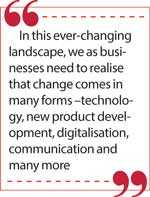Sunday Dec 14, 2025
Sunday Dec 14, 2025
Wednesday, 25 September 2019 00:00 - - {{hitsCtrl.values.hits}}

Change is inevitable. Organisations cannot shy away from change anymore; as the biggest drawback for companies to grow in this era, is change. When one gets comfortable with the current processes,  technologies, products, mode of working, its human nature to get used to following a routine. Change is something that completely chaotically changes routine; while providing better opportunities. At a governance level, organisations that fail to see change as a requirement fails.
technologies, products, mode of working, its human nature to get used to following a routine. Change is something that completely chaotically changes routine; while providing better opportunities. At a governance level, organisations that fail to see change as a requirement fails.
In general, culture, thinking and strategy always comes from a top-bottom approach. This means that decisions, ideology, innovating thinking, the vision comes from the top tiers and flows into the middle tiers and into the lower tiers. As seen in the past, companies that have failed to adapt to change at the right time, failing to see the future – Kodak, Nokia, have been overtaken.
In this ever-changing landscape, we as businesses need to realise that change comes in many forms –technology, new product development, digitalisation, communication and many more. Let’s look at these four change categories.
nChange in Technology if not addressed, will always see you a step behind the game. If technology enables a manufacturing organisation to provide X amount of output and doesn’t see the opportunity to invest in a technology which enable for an output of X + 10 in a day, they fail to gain an output of 10 x 360 output a year. Another example we see today is the global race of Telco’s from 4G to 5G
nChange in New Product Development if not addressed and a product doesn’t evolve, a competitor would storm in and take over the market. Yahoo, Motorola and BlackBerry are few notable global examples
nChange to Digitalisation has enabled sustainable governance and enabled businesses opting for artificial intelligence to make life easy and lower costs; which are enabled only due to opting for change
nChange in Communication has seen that the good old ways of communicating were not the cheapest media. However, now with programmatic marketing and digital advertising, reaching the exact people you want is much easier. This is due to the change in communication
Corporates that have invested on BoardPAC for governance, and BoardPAC as a solution to the governance platform for meetings, have now been extended in organisations to their middle tiers, in addition to the top tiers, for executive meetings.
This is a result of realising the importance of sustainable governance, instant communication, instant approvals, paperless solutions, easy searching and archiving, and other features that enable them to keep up with the pace of global digitisation. It’s only with time can we say how digitalisation of meetings can play a bigger role in the long-run across the platform of organisations.
Change requires effort, time and resources. If an organisation’s goals seem to be headed in a direction that is going in the right path, tomorrow when you wake up, while that goal still exists, your right direction ideally may be a direction that you didn’t perceive before. The path to this new direction may have a shorter, more effective route. The route you currently are taking may not be the best route in the longer run.
This is like getting onto a highway. The option may be a bit costly with a toll fee, but your destination is reached much more efficiently. Change is a highway. Get on it or lose to your competition.
(The writer is a Chartered Marketer who is currently heading the global marketing function for over 20 countries including the US, Australia, Singapore, Malaysia, South Africa, India and Sri Lanka as a Global Marketing Manager for a leading multinational IT company, backed with experience and exposure in management, advertising, sales and marketing.)